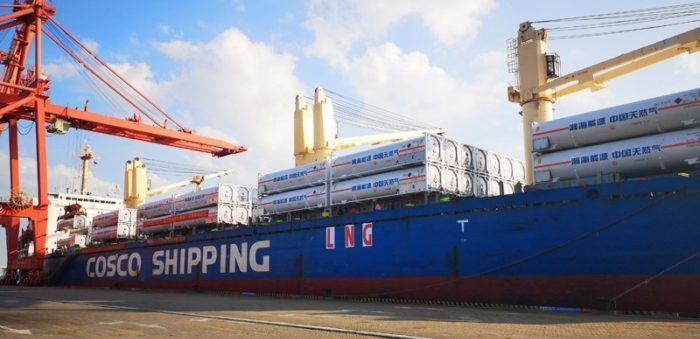A feeder container ship loaded with 130 LNG tank containers sailed from the Port of Yangpu of Hainan Province to the Port of Jinzhou in November. This is part of an LNG trial project; China’s first-ever attempt to transport the surplus capacity of Hainan terminal to its northern part via LNG tank containers.
Namely, the transmit of LNG is an innovation for China and it’s a project approved by China’s National Development and Reform Commission, National Energy Administration and Ministry of Transport. The project is of a big importance since it aspires to satisfy the higher demands concerning winter heating with clean energy and ensure the LNG supply in northern China.
[smlsubform prepend=”GET THE SAFETY4SEA IN YOUR INBOX!” showname=false emailtxt=”” emailholder=”Enter your email address” showsubmit=true submittxt=”Submit” jsthanks=false thankyou=”Thank you for subscribing to our mailing list”]
All of the 130 LNG tank containers were developed and constructed by CICM Enric. China is a big supporter of the natural gas production, supply, storage and marketing system. China’s demand on natural gas is increasing rapidly since last winter there was a lack of natural gas which was then revealed during spring. In addition, the situation is expected to get worse. Up to now, the escalating conflict between supply and demand has restrained sustainable development of the domestic natural gas industry.
Moreover, China has seen an unprecedented increase on natural gas consumption over the years and there are a lot of barriers when trying to manage LNG demand, especially during the heating season. According to Wood Mackenzie, China’s LNG imports are approximately at 50 million metric tons in 2018, an increase of 12 million tons over 2017.
The International Energy Agency indicated during Gas 2018 that China is to become the world’s largest importer of natural gas and by 2023 will import 171 billion cubic meters of natural gas with LNG being more than the 50% of total imports.
In April 2018 both the NDRC and the NEA supported that enhancing the gas storage and the peak shaving ability is a major part of:
- promoting the construction of the natural gas production, supply, storage and marketing system;
- calling for the construction of a multi-tiered gas storage and peak shaving system based on interlinked pipe networks. This system will have underground gas storage reservoir and coastal LNG terminals as the major part, centralized and large-size LNG storage tanks in key inland areas as the minor part, and gas field peak load adjustment, interruptible provision, alternative energy and other adjustment means as the supportive part.
To transfer natural gas from south-to-north, there are two options:
- the commonly used pipelines;
- the popular non-pipeline model from the central and western parts of China.
As far as the two ways of transporting LNG are concerned, Yongsheng Xu, General Manager of Nantong CIMC Energy Equipment CO, stated that LNG was partly used for the purpose of peak load adjustment in China; today, it is thought as one of major gas sources due to the tighter natural gas supply. The south-to-north natural gas transmit is crucial for China and it is a strategically important link in building the natural gas production, supply, storage and marketing system.
The 130 LNG tank containers are ideal for storage and transportation and have successfully transferred a large volume of surplus natural gas from south-to-north via ships, with the gasification capacity of a single tank container reaching 25,000 cubic meters.
What’s more, the LNG tank container has many advantages in the whole industrial chain of natural gas, such as an optimisation and supplement of traditional industrial chain and becomes a new measure for securing winter gas supply in China. Also, large-scale transportation is based on large volume, extensive coverage, flexibility, safety, low-cost investment and short-term gains.
When the intermodal transport works on a large scale and gets commercialised, it will extend to inland markets and have a big influence on the LNG industry.
In addition, with its larger application scope and stronger adaptability performance, the new LNG tank container transportation model can be further extended to railway, road and water transportation, aim the door-to-door supply from terminals to users and transmit natural gas to areas not covered by existing pipe networks, enhance the country’s natural gas storage and supply capacity and become a method crucial for national well-being, the people’s livelihood and the country’s energy security.
Finally, CIMC is proud of its best-of the-class LNG tank container technology and optimistic about the market prospects.






























































